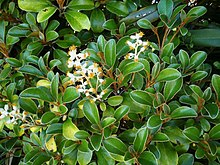Brachyglottis elaeagnifolia
| Brachyglottis elaeagnifolia | |
|---|---|

| |
| Scientific classification | |
| Kingdom: | |
| (unranked): | |
| (unranked): | |
| (unranked): | |
| Order: | |
| Family: | |
| Tribe: | |
| Genus: | |
| Species: | B. elaeagnifolia
|
| Binomial name | |
| Brachyglottis elaeagnifolia | |
| Synonyms | |
|
Senecio elaeagnifolia | |
Brachyglottis elaeagnifolia is a species of flowering plant in the aster family, Asteraceae. It is endemic to New Zealand,[1] where it is limited to the North Island.[2]
This is a shrub growing up to 3 meters tall. The branches are grooved and the smaller branches and petioles are coated in whitish or pale brownish hairs. The leathery leaves are widely lance-shaped to oblong and up to 9 centimeters long. The upper surfaces are shiny and hairless and the undersides have silvery whitish or brownish hairs. The inflorescence is a panicle of woolly flower heads containing disc florets. The fruit is an achene 1 to 2 millimeters long with a pappus of barbed white hairs up to 5 millimeters long.[1]
Volcanic debris on Mount Taranaki has been colonized by this species, which occurs in dense stands up to 100 years old.[3]
References
- ^ a b Brachyglottis elaeagnifolia. NZ Flora.
- ^ "Brachyglottis elaeagnifolia". Germplasm Resources Information Network. Agricultural Research Service, United States Department of Agriculture. Retrieved 23 January 2018.
- ^ Clarkson, B. D. (1990). A review of vegetation development following recent (<450 years) volcanic disturbance in North Island, New Zealand. New Zealand Journal of Ecology 14, 59-71.
